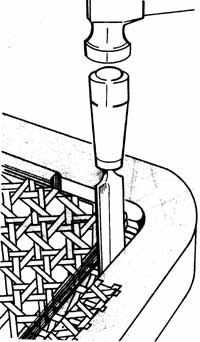How to Repair Caning
In antique furniture, caning is usually handwoven. It is threaded through individual holes in the frame and woven in strand by strand. This type of caning should be replaced by a professional. In most newer furniture, the cane is prewoven. An entire sheet of cane is attached in a groove around the open frame. Sheet cane is easy to replace.
Start by removing the old cane. If you can, pull the cane out of the groove, using a chisel to pry up the spline that holds it. If the spline is stubborn, you may have to soak the area with a towel soaked in very hot water and wrung almost dry. When the adhesive has softened, place a block of wood under the caning and tap the block with a hammer. This should dislodge the caning and the spline from the seat frame. After removing the cane, clean out the groove with a chisel. Make sure it's completely clean and dry before you install the new cane.
Advertisement
To replace the cane, buy a new spline and new prewoven sheet caning, about 1 to 11/2 inches larger all around than the opening. Make sure the spline is the right width for the groove. Soak the cane and the spline in warm water for about 10 to 15 minutes to soften the fiber.
When the spline and the cane are pliable, blot them dry with a towel. Lay the caning over the groove, shiny side up. Starting at the center of one short side, pound the edge of the caning into the groove with a narrow wood wedge -- cut the wedge from a 1 X 2 or a 1 X 3, and use a hammer to tap it along the caning.
The bottom of the taper on the wedge should be slightly smaller than the groove. Work along the side of the frame toward the corners, wedging the cane firmly and squarely down into the groove. If the cane isn't securely wedged, it will come loose.
When the first side of the cane is in place, clamp the caned edge between two pieces of 1 X 2 or 1 X 3 to prevent the caning from popping out of the groove. Then stretch the sheet of cane across the frame and wedge the opposite side, starting at the center and working out.
Repeat the procedure, clamping each side as you go, to secure the remaining sides. As you work, the caning may start to dry out. If necessary, rewet it to keep it pliable.
When the caning has been tapped into the groove all around the frame, trim off any excess at the outside corner of the groove. Set a sharp chisel into the groove to cut the cane. Then lay a narrow bead of white glue all around the groove on top of the caning.
Blot the spline dry, and force it into the groove over the caning, using a wooden or rubber mallet to drive it into the groove. Pull the spline tight as you go, and ease it around the corners. You may have to install the spline in several pieces; if so, make sure the ends butt together tightly to form a continuous spline. Finally, wipe off any excess glue.
Let the glue and the cane dry completely. As it dries, the caning will become taut. Let the job set for at least a week before you use it.
The final section of this article is devoted to repairing mirrors and frames.
